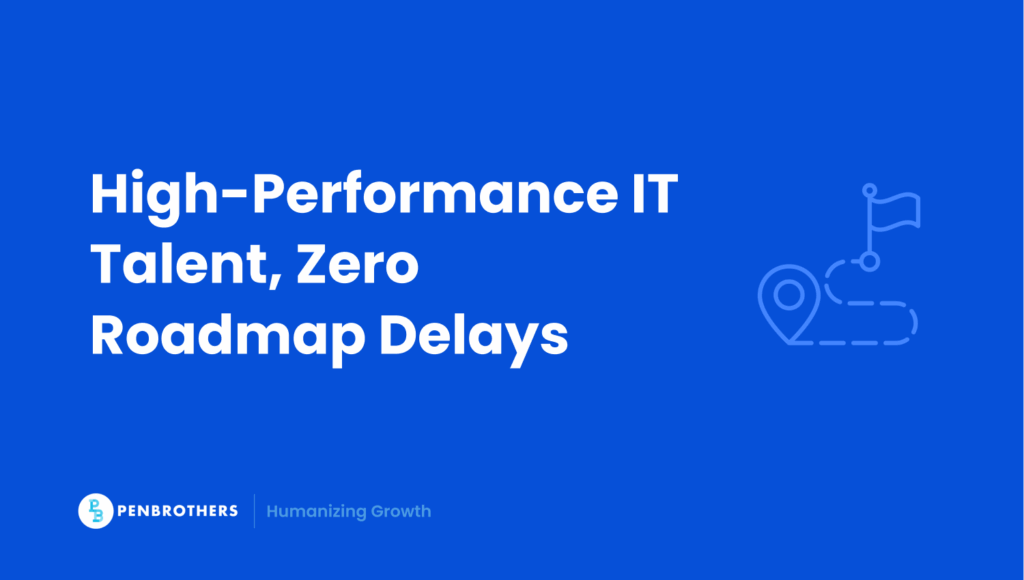You’re two sprints behind. Your front-end developer is stretched thin. And your investors are asking tough questions.
This is what slow hiring looks like.
In-house tech recruitment can take 6–12 weeks per role, according to Ideaware. That’s a quarter of your year gone before a new developer even commits their first line of code. Multiply that delay by three open roles, and your product roadmap is no longer just delayed, it’s at risk.
Meanwhile, the team you do have is burning out. Features are being deprioritized, code reviews are rushed, and QA suffers. Left unchecked, this cycle erodes product quality, delivery confidence, and team morale.
Key Takeaways
- Offshoring is a Strategy for Speed, Not Just Cost: The primary driver for modern offshore IT staffing is to overcome slow domestic hiring cycles (6-12 weeks per role) that delay product roadmaps. It is a strategic tool to maintain development momentum and prevent team burnout.
- Modern Offshoring Means Full Integration: Successful offshore staffing in 2025 is defined by staff augmentation, not traditional outsourcing. This involves embedding developers directly into your existing teams, using your company’s tools (like Jira and Slack), and ensuring at least 2-4 hours of daily time zone overlap for collaboration.
- Success Depends on Avoiding Common Pitfalls: Many offshore initiatives fail due to predictable mistakes. These include setting misaligned expectations, having poor communication workflows, conducting shallow candidate vetting that leads to low code quality, and ignoring critical security and IP risks.
- Hire for Product Mindset, Not Just Technical Skill: The best offshore engineers are product-aligned (they understand the “why”), are strong documenters (critical for remote work), and demonstrate proactive ownership by identifying risks early. These traits are more valuable for maintaining roadmap velocity than pure coding ability alone.
Why Offshore IT Staffing Is the Strategic Answer, Not Just a Cost Saver
Let’s be clear: offshore IT staffing isn’t just a budget hack. It’s a strategic lever.
Done right, offshore staffing gives product leaders the ability to:
- Scale fast without lowering your hiring bar: Bypass long local recruitment cycles and onboard qualified engineers in weeks, not months.
- Tap into niche technical expertise: From AI/ML specialists to mobile developers and cloud engineers, global talent pools open access to skills that are scarce or overpriced in your local market.
- Protect your core team’s bandwidth: Keep your in-house engineers focused on roadmap-critical features, while offshore teammates support complementary development, QA, or integration work.
The global offshore software development market is projected to hit $151.9 billion in 2025 and soar to $389.7 billion by 2033, according to Decode. Asia-Pacific remains the dominant hub, growing at a CAGR of 9.16% (Blue Coding).
This isn’t about replacing your team. It’s about unlocking scale without the lag of traditional hiring.
What ‘Good’ Offshore IT Staffing Looks Like in 2025
If you’re picturing anonymous devs working in silos, it’s time to update that image.
Modern offshore staffing looks like this:
- Staff Augmentation Over Traditional Outsourcing
Forget rigid outsourcing models with limited control. Modern offshore staffing is about embedding developers directly into your existing team. These engineers attend your standups, participate in sprint planning, and are accountable for outcomes, not just output. - Embedded Collaboration Across Tools and Workflows
True offshore partners work inside your ecosystem. That means real GitHub pull requests, Jira tickets, Slack conversations, and shared documentation. You don’t hand over specs, you co-create and iterate together, just like you would with in-house teammates. - Time Zone Compatibility That Supports Agility
At least 2 to 4 hours of real-time overlap is now the baseline. This window allows for synchronous check-ins, daily alignment, and quick decision-making. The rest runs asynchronously, documented, traceable, and designed for efficiency. - Retention Systems That Prioritize Consistency
Offshore success doesn’t come from one-off hires. It’s built through long-term retention, structured onboarding, and engagement practices that keep engineers motivated and aligned with your roadmap.
The best teams operate as true extensions of your in-house squad.
Need to build one fast? Learn how companies hire remote IT experts in less than 1 month.
Common Mistakes That Derail Offshore IT Teams (and How to Avoid Them)
Hiring offshore won’t save your roadmap if you repeat these common mistakes:
1. Misaligned Expectations
The mistake: Kicking off work without clear scope, vague deliverables, or assuming that developers “just get it.”
The impact: Sprints stall, rework piles up, and trust erodes.
The fix: Define sprint-level goals with clear user stories, acceptance criteria, and velocity benchmarks. Hold weekly alignment calls and continuously reprioritize the backlog based on real progress, not assumptions.
2. Poor Communication Workflows
The mistake: Relying on ad hoc messages, scattered updates, or informal check-ins across time zones.
The impact: Tickets go missing, blockers linger, and momentum fades.
The fix: Build an async-first communication culture. Use structured tools like Slack, Loom, Notion, or Confluence to document decisions. Combine this with predictable check-in rhythms (e.g., weekly standups, demo days) to keep everyone synced even across time zones.
3. Low Code Quality from Shallow Vetting
The mistake: Hiring based on interviews alone, with no real test of skill or fit.
The impact: Code is shipped, but it’s buggy, undocumented, or doesn’t scale.
The fix: Implement multi-layer vetting. Use take-home coding tasks, live pair programming, and GitHub repo reviews. Look for engineers who don’t just write code, they explain decisions, ask clarifying questions, and think in terms of product outcomes.
4. Security and IP Risks
The mistake: Onboarding offshore developers without proper access controls or legal protections in place.
The impact: You risk data leaks, non-compliance, and even IP theft.
The fix: Enforce strict NDAs, use role-based access to systems, and maintain logs for all critical repositories. Choose partners that are experienced in handling compliance across multiple jurisdictions.
You don’t need to learn these lessons the hard way. By solving them early, you set your offshore team up for performance, not patchwork.
Curious how other tech firms build robust offshore setups? See how US tech firms outsource full-service IT support without sacrificing control or quality.
Offshore Engineers That Fit (and Ship): What to Look For
Not all offshore candidates are built for roadmap velocity.
Here’s who you want:
Product-Aligned Engineers
These aren’t just task executors. They understand the bigger picture, why a feature exists, how users interact with it, and how it supports business goals. They ask questions, raise edge cases, and think in iterations. Look for engineers who’ve worked closely with product teams or contributed to decision-making in agile environments.
Strong Documenters
In remote teams, clarity is currency. The best offshore developers don’t just write code, they write context. From detailed pull request comments to inline documentation and task updates, they make it easy for others to follow their work and build upon it. Async-ready engineers save your team from endless back-and-forth.
Cultural and Team Fit
You want developers who show up to team rituals, respect meeting cadences, and care about collaboration. They should be comfortable with asynchronous communication, timezone alignment, and giving/receiving feedback. The goal isn’t just productivity, it’s cohesion.
Bonus: Proactive Ownership
The best offshore engineers don’t wait to be told what’s broken. They spot issues early, flag risks, and propose fixes. This mindset reduces micromanagement and builds trust, fast.
How to Choose the Right Offshore IT Staffing Partner
Choosing a partner is just as critical as choosing a developer.
Here’s what to look for:
1. Time-to-Hire Speed
Can they reliably deploy qualified candidates in under 2–3 weeks?
A strong partner has a vetted talent pipeline and doesn’t start from scratch. They should be able to match you with engineers quickly without compromising quality, so you can meet sprint deadlines and roadmap milestones without delay.
2. IT-Specific Expertise
Do they specialize in tech talent or are they a generalist staffing vendor?
You need a partner that understands the nuances of software engineering roles, from DevOps to mobile to backend architecture. Look for those who screen for technical depth, agile experience, and product-focused thinking, not just resume keywords.
3. Transparent, Predictable Pricing
Are their fees flat, or will you be hit with extra charges later?
Avoid partners who tack on management fees, markups, or vague service costs. Opt for those offering clear, monthly pricing that covers everything, talent compensation, support, and administrative fees, so you can forecast your burn rate with confidence.
4. Compliance and Onboarding Support
Can they handle local labor laws, data privacy regulations, and payroll logistics?
Especially when hiring across borders, you need a partner who ensures your team is legally classified, paid on time, and protected with proper contracts and NDAs. Bonus points if they support onboarding, performance tracking, and engagement post-hire.
Start your checklist with the top IT staff augmentation companies of the year.
Final Thoughts: Scaling Without Breaking the Roadmap
Offshore IT staffing isn’t just for budget efficiency. It’s for momentum.
When hiring delays threaten your roadmap, the right offshore partner helps you:
- Deliver on time
- Protect engineering morale
- Maintain velocity across product milestones
At Penbrothers, we help growth-stage companies scale tech teams fast with Filipino engineers who integrate, ship, and stay.
Frequently Asked Questions
The main problem it solves is the slow speed of in-house tech recruitment. The article states that hiring a developer locally can take 6-12 weeks, a delay that puts product roadmaps at risk and leads to burnout for the existing team. Offshore staffing allows companies to onboard qualified engineers in weeks, not months, thus maintaining critical project momentum.
Traditional outsourcing often involves handing over a project to an external team with limited control and integration. Staff augmentation, the modern approach, involves embedding offshore developers directly into your existing team. They become part of your daily standups, work within your internal project management tools (like Jira and Slack), and are accountable for outcomes as if they were in-house employees.
The article identifies four common mistakes:
Misaligned Expectations: Not providing a clear scope, user stories, and acceptance criteria.
Poor Communication: Relying on informal messages instead of structured, async-friendly workflows and documentation.
Shallow Vetting: Hiring based on interviews alone, which can lead to poor code quality.
Security and IP Risks: Neglecting to implement proper NDAs, access controls, and legal protections.
You should look for engineers who are product-aligned, meaning they understand the business goals behind the features they are building. They should also be strong documenters, as clear documentation is essential for asynchronous teamwork. Finally, a sense of proactive ownership—the ability to spot and flag risks independently—is a highly valuable trait that reduces micromanagement.
When selecting a partner, you should prioritize four key areas:
Time-to-Hire Speed: Can they source and place qualified candidates in under three weeks?
IT-Specific Expertise: Are they specialists in technology recruitment or generalists?
Transparent Pricing: Do they offer clear, flat fees without hidden markups?
Compliance and Onboarding Support: Do they handle local labor laws, payroll, and legal contracts?






